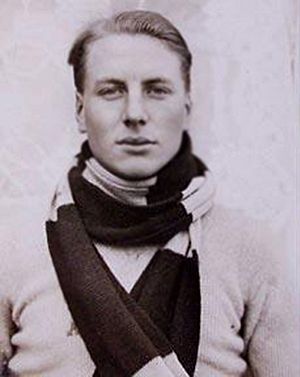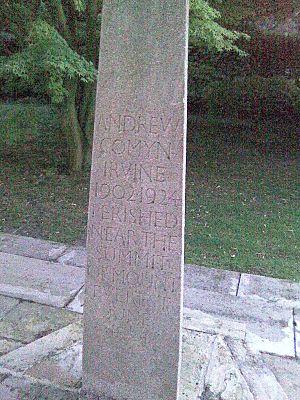Andrew Irvine (mountaineer) facts for kids
Quick facts for kids
Andrew Irvine
|
|
|---|---|
 |
|
| Born |
Andrew Comyn Irvine
8 April 1902 Birkenhead, Cheshire, England
|
| Died | 8 June 1924 (aged 22) North Face, Mount Everest, Tibet
|
| Cause of death | Mountaineering accident |
| Occupation | Student at Merton College, Oxford |
Andrew Comyn "Sandy" Irvine (born April 8, 1902 – died June 8, 1924) was a brave English climber. He was part of the 1924 British Everest Expedition. This was the third British trip to Mount Everest, the world's highest mountain.
Andrew Irvine and his climbing partner, George Mallory, tried to be the first to reach the top. They disappeared high up on the mountain. They were last seen close to the summit. No one knows if they made it to the very top before they died.
Mallory's body was found in 1999. But Irvine's body and his camera have never been found. This mystery has fascinated people for decades.
Contents
Early Life and Talents
Andrew Irvine was born in Birkenhead, England. He was one of six children. His father was a historian.
Irvine went to Birkenhead School and Shrewsbury School. He was very good at engineering. He could fix or improve almost any machine. During World War I, he even designed ideas for the War Office. These included a way for a machine gun to fire through a plane's propeller. He also designed a stabilizer for aircraft.
He was also a great sportsman, especially in rowing. His amazing rowing skills made him famous at the 1919 Henley Regatta. This led him to Merton College, Oxford, to study engineering. At Oxford, he joined the university's climbing club. He also rowed for the Oxford team in the Boat Race in 1922 and 1923.
The Everest Expedition

In 1923, Irvine joined an expedition to Spitsbergen in the Arctic. He did very well there. The leader of that trip, Noel Odell, suggested Irvine for the 1924 British Mount Everest expedition. Odell thought Irvine might be the "superman" the team needed. Irvine was only 21 years old and still a student.
Irvine sailed to the Himalaya mountains on February 29, 1924. He traveled with other team members, including George Mallory. Mallory later wrote that Irvine was reliable for everything except conversation.
During the expedition, Irvine made important changes to the team's oxygen sets. He made them work better, lighter, and stronger. He also took care of the cameras, camp beds, and stoves. Everyone liked and respected him. They admired his cleverness and hard work.
The team tried to reach the summit twice in early June but failed. There was only one more chance before heavy snows arrived. This last try went to George Mallory, the most experienced climber. Surprisingly, Mallory chose the 22-year-old Irvine over older, more experienced climbers. Irvine's skill with the oxygen equipment was a big reason for Mallory's choice.
Mallory and Irvine started their climb on June 6. By the next day, they set up a final camp at 8,168 meters (26,798 feet). From there, they would make their final push to the top. No one knows exactly when they left on June 8.
Odell, who was supporting them, saw them at 12:50 pm. This was much later than expected. He believed they were climbing the Second Step of the northeast ridge. He said they were "going strongly for the top." However, exactly which "Step" Odell saw them on became a big debate later.
They never returned to their camp. They died high on the mountain. When Mallory's body was found in 1999, a rope was still around his waist. This showed a serious rope injury. It suggests that either Mallory or Irvine fell while they were tied together. Irvine's body has never been found.
Clues on the Ridge
Discovery of the Ice Axe
In 1933, nine years after Mallory and Irvine disappeared, an ice axe was found. Percy Wyn-Harris found it at about 8,460 meters (27,756 feet). It was lying on smooth rock slabs.
The ice axe was made by a Swiss company. This matched the axes given to the 1924 expedition. Since only Mallory and Irvine had climbed that high, it had to belong to one of them.
The leader of the 1933 expedition, Hugh Ruttledge, thought the ice axe might mark where someone fell. Or perhaps its owner put it down to free their hands. Noel Odell, the last person to see them, thought it was just placed there to be picked up on the way back down.
In 1963, a special mark on the ice axe matched a mark on Andrew Irvine's walking stick. This suggests the ice axe belonged to Irvine.
Discovery of the Oxygen Cylinder
In May 1991, an oxygen cylinder from 1924 was found. It was at about 8,480 meters (27,822 feet). This was higher and closer to the First Step than the ice axe.
Since only Mallory and Irvine were on the northeast ridge in 1924, this cylinder showed how high they must have climbed. The oxygen cylinder was brought down in May 1999.
Finding Mallory's Body
In May 1999, Mallory's body was found at 8,155 meters (26,755 feet). It was found by the Mallory and Irvine Research Expedition. The body was in a basin, about 300 meters (984 feet) below the ice axe's location.
A rope was still around his waist. This showed a serious injury from a rope jerk. It strongly suggested that Mallory or Irvine fell while they were tied together. Mallory had few major injuries compared to other climbers who fell from that height. This suggests he survived the first fall. A golf ball-sized hole in his forehead seemed to be the cause of death. It might have been caused by an ice axe.
People have guessed that an injured Mallory was sliding down the slope. He might have been using his ice axe to control his speed. His ice axe might have hit a rock and bounced back, hitting him fatally.
Searching Mallory's body gave two clues that he might have reached the summit:
- Mallory's daughter said he carried a photo of his wife. He planned to leave it on the summit. No photo was found on his body. The body was well preserved. This suggests he might have left the photo on the summit.
- Mallory's snow goggles were in his pocket. This means he died at night. This suggests he and Irvine made a push for the summit and were coming down very late. If they hadn't reached the summit, they likely wouldn't have been out so late.
No trace of the two Kodak cameras was found. Irvine's diaries said he and Mallory were carrying them. This led to hopes that the cameras might be found with Irvine's body. Experts say the black-and-white film might still be developed. This could show what happened to Mallory and Irvine.
Possible Sightings of Irvine
Sighting by Wang Hong-bao
In 1979, a Chinese climber named Wang Hong-bao shared a story. He said that in 1975, he saw the body of an "English dead" at 8,100 meters (26,575 feet). The body was lying on its side, as if asleep. Wang knew the man was British because of his old-fashioned clothes. Sadly, Wang died in an avalanche the next day.
Later, Wang's tent-mate from the 1975 expedition confirmed the story. He said Wang found a "foreign mountaineer" at 8,100 meters. Since no other European climber was known to have died at that height on Everest's north side, it was likely Mallory or Irvine.
Wang's sighting helped find Mallory's body in 1999. However, Wang's description of the body ("hole in cheek") does not match Mallory's body. Mallory was face down with a forehead injury. One idea is that Wang actually saw Irvine. Another is that Wang found Mallory face up and turned him over.
In 2001, the Mallory and Irvine Research Expedition searched Wang's 1975 campsite. They found that Mallory's was the only body nearby.
Sighting by Xu Jing
In 2001, researchers interviewed survivors of the 1960 Chinese Everest expedition. This was the first expedition back to the north side since the British attempts.
The deputy leader, Xu Jing, said he saw a dead climber. The climber was lying on his back in a rock hollow. Since only Mallory and Irvine were lost on the north side before 1960, and Mallory was found lower down, Xu likely saw Irvine. However, Xu's sighting was brief. He was in trouble during his descent. He remembered seeing the body but was unsure exactly where.
Sighting by Wang Fu-chou
In 1965, another member of the 1960 Chinese expedition, Wang Fu-chou, gave a lecture. He said, "At an altitude of about 8,600 meters (28,200 feet), we found a corpse of a European." When asked how he knew the man was European, he simply said, "He was wearing braces."
Recent Searches for Irvine
In 2010, a team led by Tom Holzel searched for Irvine. They used aerial photographs of Everest. They found a possible object at about 8,425 meters (27,641 feet). This was less than 100 meters (328 feet) from where the ice axe was found. It looked like a body lying in a rock slot, just as Xu Jing described.
A new expedition was planned for December 2011 to explore this area. They hoped to find Irvine and the camera with him. Climbing in winter meant less snow, which would increase their chances.
In 2019, Mark Synott led a team to investigate the possible location. They found it was just an optical illusion. Synott later suggested that the 1975 Chinese expedition might have found both Irvine and the camera.
Inspiring Words from Friends
Andrew Irvine's friends remembered him fondly.
- A family friend wrote: "One cannot imagine Sandy content to float placidly in some quiet back-water, he was the sort that must struggle against the current and, if need be, go down foaming in full body over the precipice."
- Arnold Lunn, a friend, wrote: "Irvine did not live long, but he lived well. Into his short life he crowded an overflowing measure of activity which found its climax in his last wonderful year, a year during which he rowed in the winning Oxford boat, explored Spitsbergen, fell in love with skiing, and – perhaps – conquered Everest. The English love rather to live well than to live long."
Images for kids
See also
 In Spanish: Andrew Irvine para niños
In Spanish: Andrew Irvine para niños



